 Unless you’ve been hiding under a rock (or perhaps an apple), you’re probably aware that Windows 10 dropped and is available to install. As to why it is numbered Windows 10, given that it follows after Windows 8.1, the answer is simple: stupid programmers. Yup. You probably remember Windows 4, Consumer Edition? This was the version that followed after Windows 3.1, and ran on top of DOS. Microsoft, in their wonderful style of naming conditions, called that version Windows 95, and its successful successor was Windows 98. Application software tested for this by, you guessed it, testing for the string “Windows 9”. Now there is hopefully none of the code from the Windows on DOS branches left in the OS (except perhaps for the start button), but those applications are out there: and Microsoft didn’t want to break them. Thus the jump from Windows 8 to Windows 10 (because presumably there are no Windows 1.0 applications still running).
Unless you’ve been hiding under a rock (or perhaps an apple), you’re probably aware that Windows 10 dropped and is available to install. As to why it is numbered Windows 10, given that it follows after Windows 8.1, the answer is simple: stupid programmers. Yup. You probably remember Windows 4, Consumer Edition? This was the version that followed after Windows 3.1, and ran on top of DOS. Microsoft, in their wonderful style of naming conditions, called that version Windows 95, and its successful successor was Windows 98. Application software tested for this by, you guessed it, testing for the string “Windows 9”. Now there is hopefully none of the code from the Windows on DOS branches left in the OS (except perhaps for the start button), but those applications are out there: and Microsoft didn’t want to break them. Thus the jump from Windows 8 to Windows 10 (because presumably there are no Windows 1.0 applications still running).
[In case you’re curious, Windows 10 is not from the Windows on DOS branches: it’s lineage traces back to Windows NT 3.5, which begat Windows NT 4.0, which begat Windows 2000 (NT 5.0), Windows XP (NT 6.0), Windows 7, Windows 8 (and 8.1), and now 10. Windows-on-DOS died with Windows ME.]
In any case, Windows 10 was officially released yesterday, and for a year (until 29 July 2016) it is available as a free upgrade for anyone on a home edition of Windows 7 or greater. There’s a little Windows icon where you can reserve your copy and everything. All of the early adopters are downloading like crazy. The reports are that Windows 10 is a pretty good product (Ars Technica, Techspot, Newsweek), but they are also noting that if you don’t need it immediately…. it’s probably worth waiting a month or two for problems and patches to settle down. Then again, there are good reasons to stay on Windows 7.
- [ETA 150829: Then again, there also good reasons not to upgrade]
I would tend to agree. There have already been a number of problem reports, from odd installation problems to problems with too many items in the new start menu. I’m also leery of how upgrades vs. clean installs work: I want to see some actual reports from users in the field that Windows 7 actually upgraded well, and all applications still were in the right places and ran. That will take some time.
However, all the news is coming out now, so I figured I’d do a post to help me keep it in one place. Feel free to comment with useful articles of your own. This is the stuff that interests me:
- Upgrading an Old Machine. I have two old Windows XP machines, both with AMD processors. One (the HP) is currently turned off because the OS was showing some signs of corruption (patches were starting to fail on installs); the other is an eMachines that primarily serves as a print server on an internal network to a HP LaserJet 4. We wake it up to print, and put it back to sleep. I’m curious about upgrading this to 10. The hardware requirements are light and the OS installs and runs, but when applications go it may be a pig. You do have to pay to upgrade XP. It might be worth downloading an ISO image; the alternative is a new computer to serve as a server.
- [ETA 150829: An alternative, for an older machine, is to upgrade to Linux. Here’s how to find out if your PC is compatible with Linux]
- How To Install. There have been a few articles with tips for a hassle free install, as well as articles on how to install Windows. I think the best advice is to create a bootable backup before you start (thank you, Acronis). I’d like to hear people’s install experiences. Here’s how to do a clean install of W10, even if you’ve already installed it.
- [ETA 150801: Of course, if you’ve installed and now want to de-install, here’s how to downgrade to Windows 7, 8, etc..]
- [ETA 150801: Here’s also a Windows 10 Migration Guide]
- [ETA 150815: Then again, your manufacturer has to be on board.]
- [ETA 151106: For my Toshiba Satellite, the response from @ToshibaUSAHelp is here. It linked to the following information on upgrading a Toshiba laptop.]
- [ETA 151024: How to clean up the cruft from a Windows 10 upgrade.]
- [ETA 151024: How to enter Windows 10 Safe Mode.]
- [ETA 151024: Are upgrades mandatory? They like you to think so.]
- [ETA 151106: Then again, with Windows 10 adoption slowing, Microsoft is going to get aggressive and change Windows 10 to a “recommended” update in 2016, meaning for those systems where recommended updates are automatically installed (many systems), the installation will start automatically. If you truly want to block the upgrade, here is how you do it.]
- [ETA 151024: Irritating Installation Issues, and how to fix them.]
- Windows Updates. Windows 10 Home goes to a new upgrade approach: they are automatically installed. Still, there does appear to be ways to avoid problematic updates, and to schedule when you want your system to reboot after updates.
- [ETA 150731: You should also turn on System Restore, which is off by default]
- [ETA 150803: How to stop Windows from Update Other Systems via Peer to Peer]
- [ETA 151024: Patch lets you turn off automatic updates]
- [ETA 151024: Windows 10 Threshold Update 2 due in November]
- [ETA 151106: Major Windows 10 Update (“Redstone”), due Summer 2016]
- Wi-Fi Sharing. One problem with W10 is that it likes to share your wi-fi password with your friends. Brian Krebs had a good article on “the feature”, as well as how to disable it. So did PCWorld.
- []
- Pay to Play. I don’t play games on the computer. I futz around reading news and posting to Facebook instead. But my wife does, so it is useful to note that Windows will try to charge you to remove ads from Solitare.
- Tips and Tricks. PCWorld had 5 tips and tricks. It also changes the default browser to Microsoft Edge; Mozilla is none too happy about that. I’ll note other useful articles as I see them.
- [ETA 150815: Here’s how to fix Windows privacy problems, at least what you can.]
- [ETA 150815: How to disable Windows Quick Access View.]
- [ETA 150829: Here are 20 must know keyboard shortcuts for Windows 10, and a printable Windows 10 keyboard shortcut list]
- [ETA 150829: Here’s how to turn off Windows 10 annoying ads for Office]
- [ETA 150829: Here’s how to cure Windows 10 worst headaches.]
- [ETA 151024: How to turn off the Windows 10 Keylogger]
- [ETA 151024: Useful Start Menu Tricks]
- [ETA 151024: How to recover your Windows 10 Admin Password.]
- [ETA 151106: How to use Windows 10’s Reliability Monitor to fix and fine-tune your PC]
- [ETA 151106: How to stop Windows 10 from saving files to OneDrive]
- Privacy Issues. Another problem with W10 is that it has numerous privacy concerns. Then again, these problems may be in Windows 7, 8, and 8.1.
- [ETA 150803: Opting Out of Upgrade Spying.]
- [ETA 151106: How to reclaim your privacy in Windows 10, piece by piece]
- [ETA 151106: Microsoft Says It Cannot Stop Windows 10 From Spying On You, Doesn’t Think You Should Be Concerned]
- [ETA 151106: Microsoft needs to fit Windows 10 with a data collection ‘off switch’]
[ETA 150731: PCWorld has also published a superguide bringing together all their articles. Note that many of the links they have are also linked above.]
So what are your thoughts? Did you upgrade from Windows 7? What do you think of Windows 10 on a former Windows 7 machine (for the record, I’ve got an intel Core i3, 2.4 GHz, with 4GB (3.80 available) memory. The other Windows 7 laptop is an i5 processor. The old XP print server is an AMD Athelon 64 3200 with 160GB disk and 512MB memory (I think the HP has more memory, perhaps 2GB)). (XP issue is OBE: We installed a Dlink Printer Server card instead.) Have you upgraded an XP era machine, and was it worth it? What installation problems did you run into? What do you think of the new OS?



 Every year we go to a fascinating show that is impossible to describe. The show is the finale of the
Every year we go to a fascinating show that is impossible to describe. The show is the finale of the 
 In the fall of 2009 into the late summer of 2010, one of my favorite TV programs,
In the fall of 2009 into the late summer of 2010, one of my favorite TV programs,  Let’s talk a little about the actors and what they brought, and how their characters worked in the story. In the lead position was
Let’s talk a little about the actors and what they brought, and how their characters worked in the story. In the lead position was  As you probably know by now, I tend to write obsessively
As you probably know by now, I tend to write obsessively 
 Sometimes, things just work out. For a while, it was looking like I wasn’t going to see any theatre this weekend. First, my Sunday evening show (which I had on my calendar for Saturday), “
Sometimes, things just work out. For a while, it was looking like I wasn’t going to see any theatre this weekend. First, my Sunday evening show (which I had on my calendar for Saturday), “ Yes, I said drawing and projections. Look at the two publicity photos I selected at the right. The show starts with actors in coveralls seeing various images projected on what appears to be a white screen on the back of the stage. Suddenly, they start drawing on the screen. And drawing. And tracing. And when they are done — it is a drawing of Astro Boy. Suddenly, they are running and ripping down what they have just drawn, and the episode begins.
Yes, I said drawing and projections. Look at the two publicity photos I selected at the right. The show starts with actors in coveralls seeing various images projected on what appears to be a white screen on the back of the stage. Suddenly, they start drawing on the screen. And drawing. And tracing. And when they are done — it is a drawing of Astro Boy. Suddenly, they are running and ripping down what they have just drawn, and the episode begins. In the last day or two, I’ve been talking heavily about chum and stew. Hungry yet? Perhaps these food related items will whet your appetite:
In the last day or two, I’ve been talking heavily about chum and stew. Hungry yet? Perhaps these food related items will whet your appetite: Continuing the cleaning of the collected links, here are a few articles and comments related to cybersecurity. Note: Those who read
Continuing the cleaning of the collected links, here are a few articles and comments related to cybersecurity. Note: Those who read  It’s an oddly stormy July day here in Southern California (a bit worrisome because I have outdoor theatre tickets tonight). Still, storms make it a perfect time for some stew. I’ve also got two other themed articles brewing on the back burners (one on food, and one on cybersecurity), but the haven’t quite set up right yet. So let’s dig into the stew:
It’s an oddly stormy July day here in Southern California (a bit worrisome because I have outdoor theatre tickets tonight). Still, storms make it a perfect time for some stew. I’ve also got two other themed articles brewing on the back burners (one on food, and one on cybersecurity), but the haven’t quite set up right yet. So let’s dig into the stew: